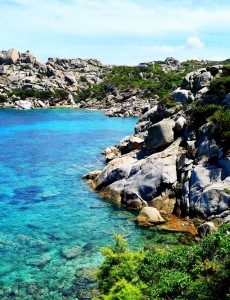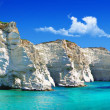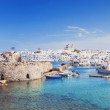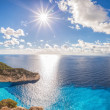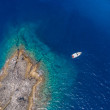
Aeolian Islands
Where Volcanic Drama Meets Mediterranean Calm: A First Glimpse of the Aeolian Islands
Approaching the Aeolian Islands by sea feels like entering a living myth. Rising abruptly from the Tyrrhenian Sea, each island offers a different emotion—Stromboli with its constant volcanic breath, Salina wrapped in vineyards and quiet green slopes, Lipari lined with whitewashed houses and vibrant harbors. This archipelago, just off the coast of northern Sicily, is not just a destination; it’s a collection of seven characters, each with its own story, texture, and rhythm.
From the first moments offshore, the Aeolian landscape commands attention. Jagged coastlines of black obsidian and soft pumice alternate with calm bays where fishing boats drift at anchor. The air carries hints of wild herbs and salt, and the islands’ silhouettes change with the light—harsh and dramatic at midday, softened by golden tones at dusk. It’s no surprise that these volcanic isles are part of a UNESCO World Heritage Site, where geology and culture are inseparably intertwined.
For travelers researching an Aeolian Islands travel guide, the archipelago delivers far more than the usual beach holiday. Things to do in the Aeolian Islands range from hiking crater rims and exploring ancient ruins to discovering black-sand beaches accessible only by boat. Lipari offers a lively balance of history and nightlife, while Filicudi and Alicudi are retreats for those seeking silence and raw nature. Each island presents its own version of paradise.
Below the surface, the sea surrounding the Aeolian Islands teems with marine life. In the clear waters between the islands, snorkelers and divers can spot groupers, barracudas, octopuses, and even the occasional sea turtle. Rocky seabeds and submerged lava formations create natural sanctuaries for biodiversity, while shallow bays offer calm, fish-rich waters ideal for easy underwater exploration.
Whether you're planning your Aeolian Islands itinerary or simply looking for the best islands to visit in the Aeolian Islands, this corner of the Mediterranean is as varied as it is unforgettable. Travelers interested in visiting the Aeolian Islands will find a perfect mix of authenticity, landscape, and tranquility. And for those seeking a deeper kind of travel—one guided by winds and coastlines rather than roads—the sea offers the most immersive entry point of all.


Navigating the Elemental Beauty of the Aeolian Islands by Sea
There’s no better way to understand the Aeolian Islands than from the deck of a boat. The sea is not just the space between the islands—it’s the main artery that connects them, shapes them, and reveals their hidden corners. Sailing here means slipping into a rhythm shaped by wind, light, and volcanic stone, discovering a Mediterranean that still feels wild and deeply alive.
Sailing the Aeolian Islands is not about rushing from one stop to the next, but about allowing the coastlines to unfold slowly. Each island invites a different pace: Lipari offers easy anchorages and access to lively towns, while Stromboli—especially by night—offers the spectacle of glowing lava cascading down the Sciara del Fuoco, best admired from a safe offshore distance. In Panarea, the smallest and most fashionable island, sailors can drop anchor near offshore islets and snorkel through underwater rock gardens in crystal-clear waters.
Some of the most memorable moments come not from reaching a destination, but from the journey between them. The passage from Salina to Filicudi, for example, is a stretch of sea often crossed in near silence, broken only by seabirds or the splash of dolphins beside the bow. Along the way, stops at small coves like Cala Junco or the pumice quarries of Lipari reveal stunning textures of coastline accessible only by water.
Whether you’re seeking a skipper charter Aeolian Islands for a guided exploration or prefer the independence of a Aeolian Islands yacht charter, the experience is tailored by the wind and sea. A Aeolian Islands catamaran charter offers space and stability for families and small groups, while a monohull appeals to those who chase the feeling of leaning into the wind. For travelers who want to explore beneath the surface, Aeolian Islands snorkeling is exceptional in the rocky coves of Basiluzzo and around the submerged craters near Vulcano.
Is the Aeolian Islands good for sailing? Absolutely. With short distances between islands, a range of safe anchorages, and spectacular scenery at every turn, it’s one of the most rewarding destinations for Mediterranean cruising. From quiet mornings moored off Salina to sunsets beneath the cliffs of Alicudi, every day on an Aeolian Islands sailing cruise offers new perspectives.
With years of local experience and deep familiarity with these waters, IntersailClub acts as your expert navigator—reading the wind, choosing the best moorings, and guiding you toward the Aeolian Islands’ most unforgettable moments, all from the sea.

Echoes from the Sea: Tracing the Cultural Soul of the Aeolian Islands
The Aeolian Islands are more than a volcanic chain scattered across the Tyrrhenian Sea—they are a living museum of maritime life, shaped by millennia of seafaring, trade, and island traditions. Their culture is deeply rooted in the rhythms of the sea, and every anchorage, village, and cove carries echoes of ancient encounters.
At the heart of Aeolian Islands history lies a legacy of volcanic forces and human resilience. Settlements here date back to the Bronze Age, with evidence of prehistoric communities discovered in the caves and terraces of Filicudi and Lipari. The islands were a vital link in ancient Mediterranean trade routes, connecting Etruscans, Greeks, and Romans. Today, the remnants of these civilizations live on in the ruins of acropolises, crumbling necropolises, and the obsidian artifacts that once made Lipari a center of commerce.
The islands’ archaeology is among the richest in southern Italy. Lipari’s archaeological museum, perched above the main harbor, offers a deep dive into millennia of island life—its exhibits span Greek amphorae, Mycenaean ceramics, and Roman sarcophagi, all retrieved from land and sea. The underwater archaeology around Panarea and Basiluzzo tells an even more dramatic story, with submerged ruins that hint at once-thriving coastal settlements now claimed by the waves.
Yet the Aeolian Islands' culture is not only preserved in artifacts—it’s lived every day in the islanders’ connection to the sea. In Salina, fishermen still rise before dawn to set out from the harbor; in Alicudi, life follows the pace of the tides. Local dishes like capers in olive oil, lentil soup from Vulcano, or swordfish grilled on wood embers are expressions of this enduring bond with land and water.
Aeolian Islands life is at once simple and profound, defined by traditions that have weathered centuries without losing their essence. From religious processions that bless the fishing boats to stories passed down about ancient eruptions and sea crossings, each island holds its own version of island identity—always marked by a horizon line and the scent of salt in the air.
Exploring this world by boat adds a deeper layer of understanding. Sailors approach towns as they were meant to be seen: from the sea, with harbors opening like pages of history. Every coastal path, chapel, and cliffside farm reminds us that the Aeolian Islands are not only destinations—they’re a testament to how people have always lived in harmony with the elements.
Sailing Seasons in the Aeolian Islands: When Wind and Light Align
June is the hottest month in Havana with an average temperature of 27°C (81°F) and the coldest is January at 21°C (70°F) with the most daily sunshine hours at 11 in July. The wettest month is June with an average of 80mm of rain. The best month to swim in the sea is in August when the average sea temperature is 30°C (86°F).
Check all Statistics in AccuweatherTides of Celebration: Seasonal Events in the Aeolians
All destinations in Mediterranean Sea
-

-

-

-

-

-

-

-

-

-

-

-

-

-

-

-

-

-

-

-

-

-

-

-

-

-





